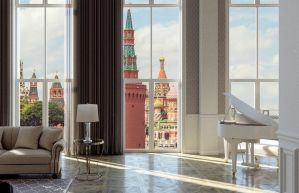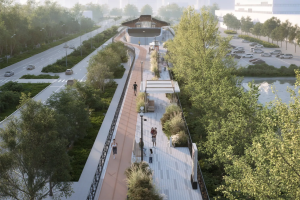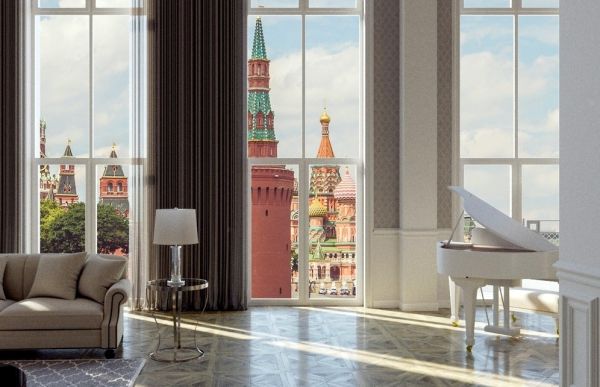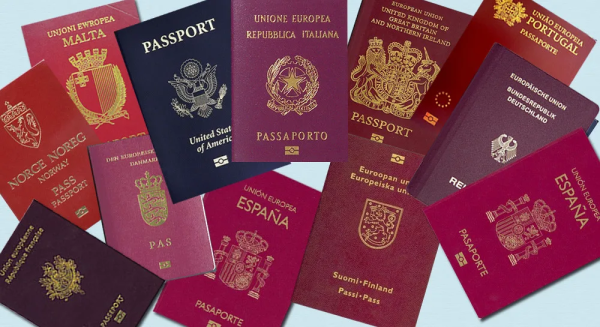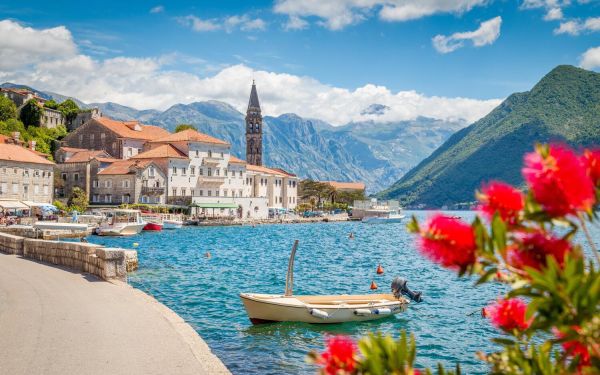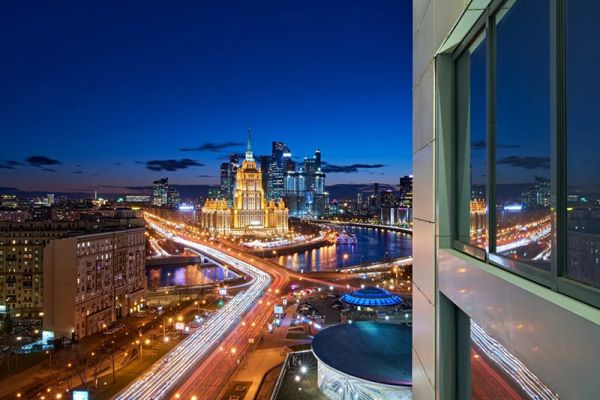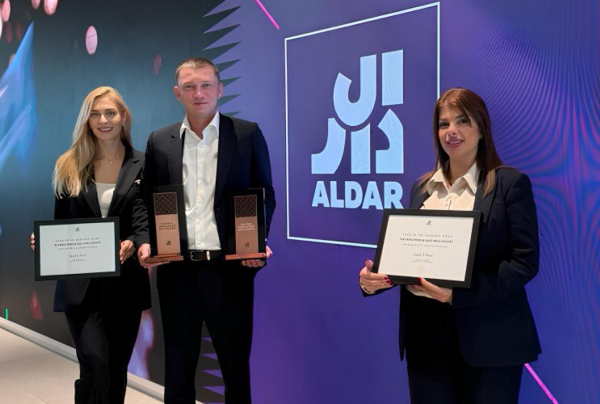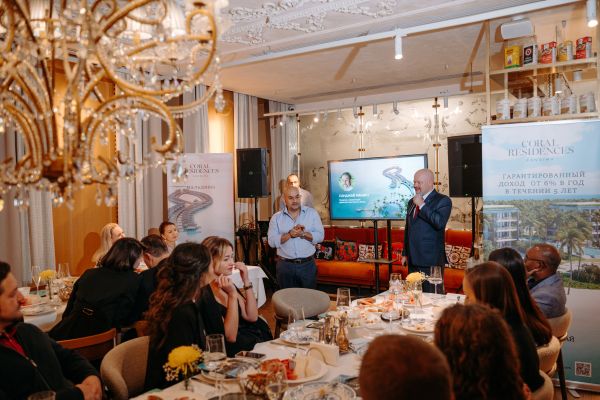The special atmosphere of Arbat is created not only by its history and architecture, but also by iconic infrastructure objects. Within walking distance from any point in the area, there are numerous museums, private art galleries, theaters, and shops with a long history. In the district, you can find both luxurious restaurants with the best views of Moscow, and small "secret" cafes tucked away in the side streets. Creative universities, research institutions, and embassies create a unique intellectual and cultural environment in the area, making it a pleasant and comfortable place to be and live.
The first legendary cultural institution that greets visitors to the district almost immediately after leaving the metro is the "Khudozhestvenny" cinema. It first opened its doors in 1909 and was redesigned by architect Fyodor Shekhtel in 1913 to increase capacity. During Soviet times, it was frequented by intellectuals, and even in recent history, the cinema has maintained its special aura. In addition to showing mainstream movies, it also screened art house and festival films, including the "ArtDocFest." Two years ago, the cinema closed for reconstruction, which is expected to be completed in 2017.
"Of course, the Vakhtangov Theater gives the Arbat area a special cultural atmosphere," says Polina Medelyanovskaya, Director of Key Client Relations at Kalinka Group. "It creates an intellectual, academic, and cultural atmosphere here. You shouldn't overlook the abundance of architectural, cultural, and historical landmarks that Arbat is famous for. Here, you can find writer's house-museums, old mansions that were frequented by famous personalities, and unique buildings like the wooden Porokhovschikov House."
The Arbat area and its surroundings are home to a concentration of art galleries, such as A3, ASTI, "Art Residency," "Cinema Gallery," "Art 21," and many others. "As an agency, we often receive requests from clients looking for gallery spaces in the Arbat side streets," asserts Kristina Tomilina, Director of Sales at Savills City Real Estate in Russia.
Undoubtedly, the largest concentration of cafes and restaurants is on pedestrian Arbat. However, locals consider such places too touristy. "Those who come to see and experience the real Moscow, of course, go to the Ministry of Foreign Affairs and Old Arbat, and then turn onto New Arbat. This is the standard 'tourist route.' But those who live here or simply know the area like the back of their hand prefer quiet, hidden side streets," notes Kristina Tomilina. "In this area, small restaurants in the closed courtyards of pre-revolutionary buildings have become fashionable. They are shielded from passersby by lush greenery and have small, inconspicuous signs for 'regular customers.' These places have become the new Mecca for Arbat residents. Art enthusiasts meet with artists in small cafes where they exhibit their works right on the café walls."
For the affluent clientele, there are luxurious representative restaurants. White Rabbit, which entered the top 20 best restaurants in the world this year, is located in Smolensky Passage under a glass dome. On Novy Arbat, you can visit the "Barashka" restaurant by Arkady Novikov, where lamb, vegetables, and herbs are specially imported from Azerbaijan. In the Lotte Plaza, you can find the renowned Kalina Bar, as well as the Ginza Project restaurant "Balkon," which offers over 200 dishes from various world cuisines.
At the end of Old Arbat, near the Smolenskaya metro station, stands the Smolensky department store. It was built in the 1920s and used to be a Torgsin store, selling goods for foreigners. "This store became the prototype for the currency store destroyed by Koroviev and Behemoth in Mikhail Bulgakov's famous novel 'The Master and Margarita'," recounts Alexander Usoltsev, editor of the "Walks around Moscow" project.
Another iconic store is the culinary shop of the "Prague" restaurant. The restaurant itself, where the famous cake of the same name was invented, was closed in 2011, but the culinary shop, known for its pastries, continues to operate successfully. "This is a legendary place, many Muscovites come here specifically, the local cake is a must-have for them," the expert clarifies.
In the area, there are large modern stores such as "Smolensky Passage" or Lotte Plaza, but small antique shops and specialized stores that have been around since Soviet times are also popular. "Since 1972, the "Samoсvety" jewelry salon has been working on Arbat, which is very popular among wealthy residents of this area," says Polina Medelyanovskaya.
In general, small and home-like things are becoming a trend in the area. According to Kristina Tomilina, this trend has also affected fitness centers: there are many personal mini-fitness clubs here with individual training programs.
Intelligent environment
Not far from Arbat are some of the most prestigious universities in the country: the Gnesin Russian Academy of Music, some faculties of Moscow State University, including the journalism faculty, and the GITIS. This creates a special creative and youthful atmosphere in the area.
The presence of a large number of embassies and consulates (Canada, Great Britain, Italy, New Zealand, Lithuania, Singapore, and many other countries) also influences the overall composition of the district's population. In addition, there are many institutions of the Russian Academy of Sciences, media outlets, and ministries here.
"This environment attracts new residents to the area. For example, many buyers of our elite apartment complex "Teatralny Dom" on Povarskaya Street choose it precisely because of its proximity to embassies, museums, and theaters. It is amazing that on just one street there is such a high concentration of such institutions. Here, the residence of the German ambassador, the A.M. Gorky Literary Museum, the State Cinema Actor Theater, the Gnesinsky Concert Hall on Povarskaya, and the Institute of World Literature are located. This increases the prestige and cultural status of the district and the housing located here," says Leonid Kaprov, Senior Vice President-Commercial Director of Gals-Development.
At the same time, Arbat remains a district of contrasts, where everyone can find places to their taste. Old Arbat is for those who love to be in the midst of city events. If you step a few meters away from the central pedestrian street into an alley, you will see another Arbat, another life. "Here, the best of what reminds of old Moscow has been preserved: courtyards with friendly neighbors, tranquility and greenery of narrow streets, which are not so easy to find in the noisy tourist crowd," notes Polina Medelyanovskaya. "At the same time, vibrant life of New Arbat is nearby, representing modern Moscow with its fast pace, the whirlpool of business, cheerful parties, and coffee meetings. Here, there is a place for gatherings and lively company, as well as enthusiasts of "home" gatherings. Thanks to such diversity, the district remains a favorite place for Muscovites for walks, cultural leisure, and living.
